Review of the TP-Link Archer C2300 Router

When you have a lot of different devices in your home that are used for watching videos, playing online games or downloading files in addition to visiting websites and social networks, your router’s performance may not be enough. This primarily applies to budget routers. For a stable and fast connection even under load you need a powerful and productive router. For example, such as TP-Link Archer C2300. You can’t call it a budget router, it costs about 170 dollars. But it is twice as cheap as some top models. And its performance and functionality is more than enough for home use.
TP-Link Archer C2300 is based on a powerful processor. Of course it supports Wi-Fi 802.11ac standard, has gigabit ports, two USB ports and HomeCare security system. There is support for Beamforming, MU-MIMO, Range Boost and so on. The software functionality of the router is very rich. It has a multilingual web interface and support for cloud functions.
Appearance and equipment
I decided to start the review of TP-Link Archer C2300 not with its technical characteristics, as I usually do, but with its package and appearance. The router is delivered in a beautiful box with all the basic information about the device on it.

Everything is packed quite reliably. All the glossy parts are covered with a protective film.

The package is standard: router, antennas (they are removable), power adapter, network cable and instructions.
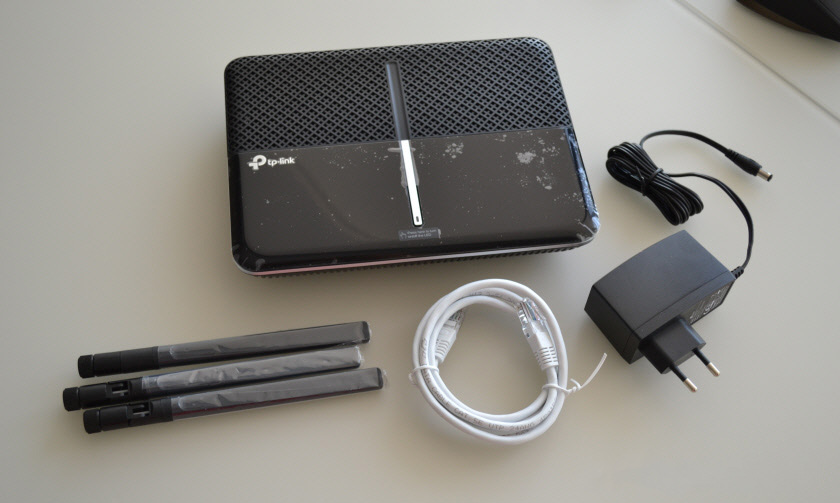
We remove the film, screw on the antennas and get this handsome guy.
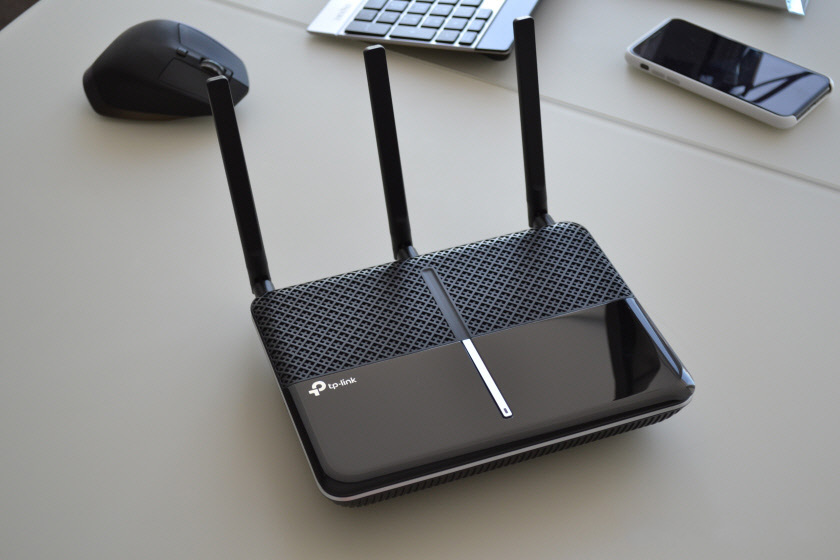
Almost the whole case is made of high-quality matte plastic. The top cover is divided into two parts. The first one is made of matte plastic with unusual texture and holes for ventilation, and the second one is made of glossy plastic (which is very dirty and scratched). There are inserts of silver plastic, which perfectly complements the TP-Link logo of the same color. Indicators are on top and are highlighted with a special strip. They can be seen only when TP-Link Archer C2300 is turned on. The lower part of the silver strip is a button to turn off the indicators. But I didn’t really understand what this button is for, because the indicators shine very dimly even in the dark.

On the left side there are three buttons: Wi-Fi On/Off (to enable/disable the wireless network), Reset and WPS. And two USB ports, one of which is 3.0 standard (it’s blue inside).
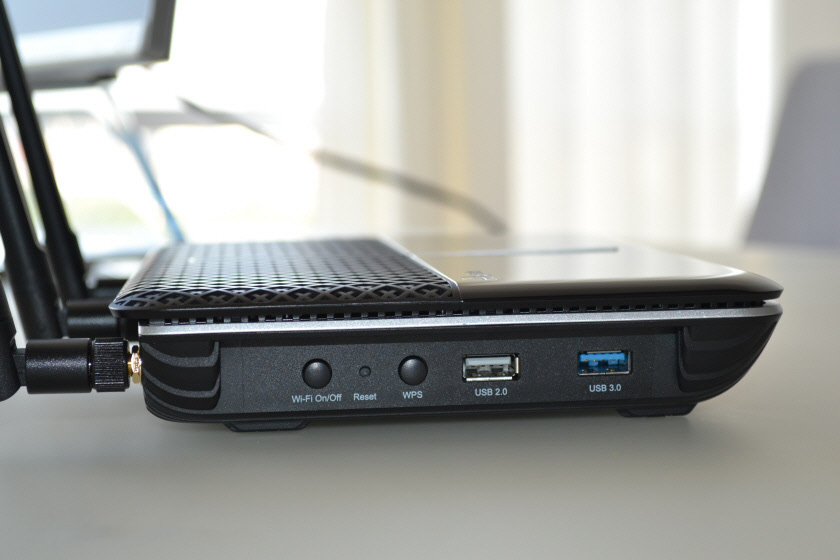
4 LAN ports and 1 WAN, as well as a power connector and On/Off button are located at the back.

The antennas are removable.
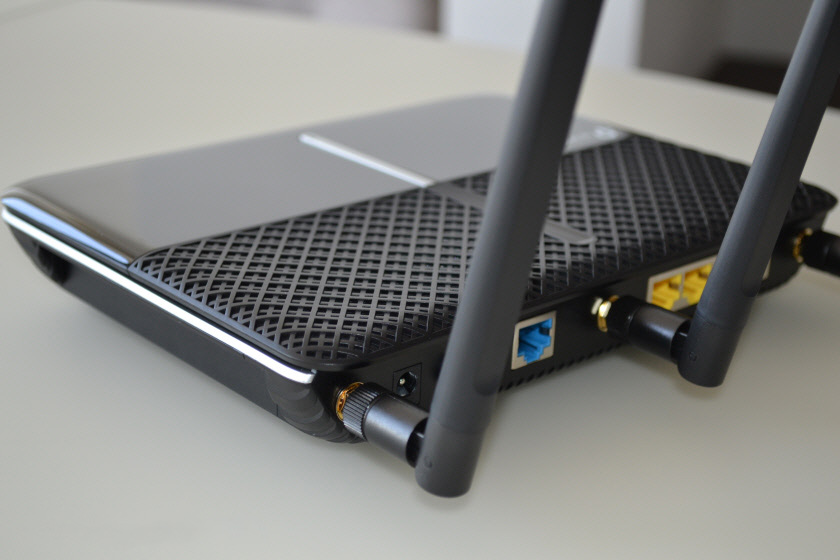
The router looks expensive. It is heavy for its size.

At the bottom there are many holes for air ventilation and cooling of the powerful iron, a sticker with factory information and some small rubber feet, which frankly speaking are ineffective. But the router doesn’t slide around as much as it does on the plastic feet.
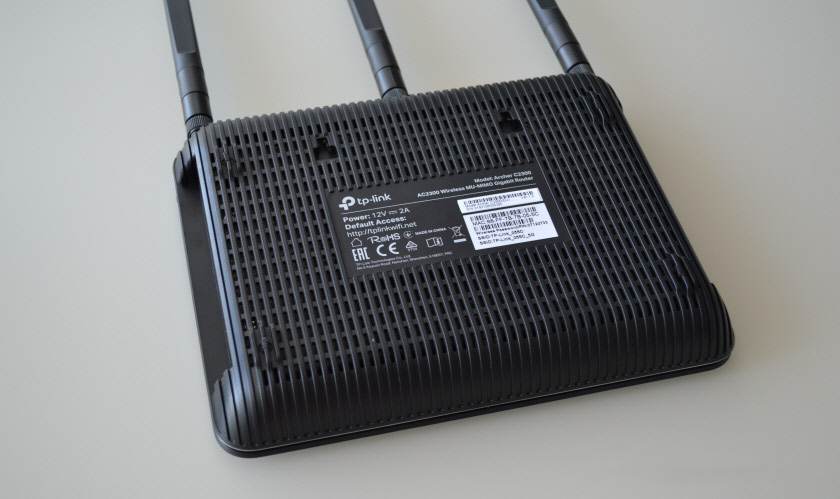
There are two holes at the bottom, which allow you to hang the router on the wall.
Quality materials and interesting design. Buttons and ports are placed conveniently. I just didn’t like the straight holes (through which you can see the board) on the top cover of the router. For air circulation and board cooling this is a very good solution, but dust will get there very easily. The board will quickly get covered in dust, which I think will make it heat up even more.
TP-Link Archer C2300 Specifications
On TP-Link’s site I found information that Archer C2300 runs on a 1.8 GHz dual-core processor with an additional co-processor. The chip is from Broadcom. What model is unknown. There is 512 MB of RAM and 128 MB of permanent memory.
Of course, such powerful hardware allows you to squeeze out a good speed on the wireless network. In the range of 5 GHz up to 1625 Mbit/s, and in the range of 2.4 GHz up to 600 Mbit/s. Adding to the performance is support for the MU-MIMO feature, so the router can transmit to multiple devices at the same time. And the Smart Connect feature will automatically assign devices to the best available Wi-Fi network band.
WAN/LAN ports are gigabit (up to 1 Gbps). There is support for the (Link Aggregation) feature, which allows you to combine two LAN ports into one and get speeds up to 2 Gbps. This can come in handy when connecting a network attached storage device (NAS) to the router. Two USB ports can be used to connect flash drives, external HDDs, or a printer. One USB port is version 3.0. The write/read speed will be much faster compared to USB 2.0. True, if you connect an appropriate drive (with USB 3.0 support).
TP-Link website says that the router comes with 3 removable antennas. But somehow it seems to me that there are also built-in Wi-Fi antennas. Two bands, high speed wireless network and MU-MIMO technology – hardly all this is possible at the expense of three antennas. I might be wrong. I couldn’t find any information on antenna power. But the network coverage is good. For a two- or three-room apartment will be enough (do not forget that the range of the wireless network depends not only on the router).
Other characteristics and features:
- Range Boost and Beamforming are features that are designed for fast and productive wireless connectivity and increased network range.
- Support for TP-Link Cloud features. You can, for example, control the TP-Link Archer C2300 via the internet.
- HomeCare security system, which includes parental controls, QoS, firewall and even antivirus. Maximizing the protection of your home network.
- OpenVPN, PPTP VPN and VPN Acceleration are available to set up a fast VPN connection.
- Multi-language, beautiful and clear web interface.
- Support for the TP-Link Tether app (with the ability to manage it over the internet).
The functionality and features of this router will be enough even for advanced users.
Wi-Fi network speed
Testing the speed of such a router as TP-Link Archer C2300 when you have a speed of up to 100 Mbps according to your Internet provider’s tariff is a bit silly and pointless. Unless it’s in the 2.4 GHz band. But I made some measurements (I tested the speed on my iPhone) and now I’ll share the results with you.
I got speeds of 90 to 100 Mbps on cable. In the range of 5 GHz router gave of course the maximum speed.

In the 2.4 GHz range (which in my apartment is very busy with neighboring networks) the speed is only slightly lower.
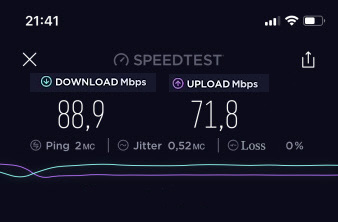
This is with the maximum signal of the Wi-Fi network. When I went to the farthest room and one division from the signal strength disappeared, the speed dropped a bit (54 Mbps incoming and 85 Mbps outgoing).
To squeeze the maximum out of this router you need an Internet channel at least 300-500 Mbps. But such speed is needed not only for connecting to the Internet, but also for stable connection of devices in the local network. For example, for watching movies on the TV from a computer or network drive via DLNA, or sharing files on the local network.
Conclusions
TP-Link Archer C2300 is a powerful, fast and very productive router. It is much cheaper than flagship models, for which there is probably no point in overpaying. Unless you are a very advanced and demanding user and clearly understand why you need such an expensive router. Archer C2300 will be enough for the most demanding tasks (online gaming, downloading files, transferring files in a local network, watching videos in 4k, etc.), even if these tasks will be performed on several devices simultaneously. A regular $20 router will just hang. Or in the best case, the speed and ping will drop dramatically, while Archer C2300 will work. This was the answer to the question “Why do you need an expensive router?”.

 TP-Link: Wi-Fi does not work. The Router Does Not Give Out Wi-Fi Network
TP-Link: Wi-Fi does not work. The Router Does Not Give Out Wi-Fi Network 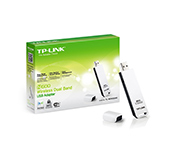 TP-Link Archer T2uh Ac600-Review, Driver Installation, Setting
TP-Link Archer T2uh Ac600-Review, Driver Installation, Setting  Fast Setting Wi-Fi Router TP-Link Archer C7 (AC1750)
Fast Setting Wi-Fi Router TP-Link Archer C7 (AC1750) 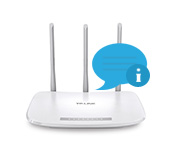 Reviews ABOUT TP-LINK TL-WR845N. OverView of the Ideal Router for Home from TP-Link
Reviews ABOUT TP-LINK TL-WR845N. OverView of the Ideal Router for Home from TP-Link